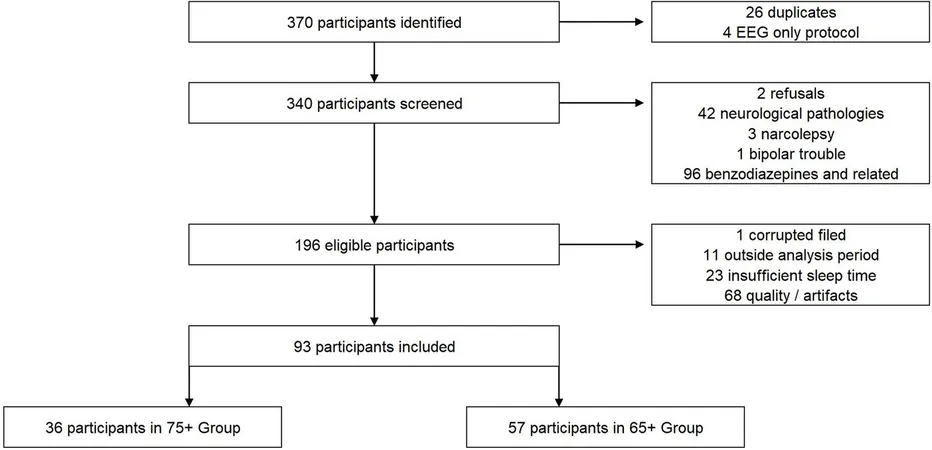
Surprising Findings on Sleep Spindles in Seniors Over 75: What You Need to Know!
2024-09-20
Overview
A groundbreaking study analyzed sleep spindle characteristics in individuals over the age of 75. Data was collected from polysomnography conducted at the Sleep Laboratory of the University Hospital of Besançon between August 2012 and May 2021. The researchers sought to understand how aging impacts sleep spindles—a crucial aspect of sleep architecture associated with memory consolidation and cognitive function.
Study Groups
The study compared two groups: participants aged 75 and older, dubbed the "75+" group, and a control group of participants aged between 65 and 74, referred to as the "65+" group. To ensure accurate data, individuals with neurological disorders or severe mental illnesses, as well as those on certain medications affecting sleep, were excluded from the analysis.
The 75+ group comprised 36 participants with an average age of 79.5 years, while the 65+ group contained 57 individuals with an average age of 68.2 years. Despite these averages, the demographic breakdown revealed 18 participants in the 75-79 age range, 14 in the 80-84 range, and only 4 in the 85-89 category.
Polysomnography Methodology
Polysomnography, a comprehensive sleep study, involved monitoring brain activity through electroencephalography (EEG) while participants spent a single night in the lab. A total of nine electrodes were used to capture sleep stage data, and various physiological parameters were recorded, allowing for a detailed assessment of sleep patterns.
The Importance of Sleep Spindles
Sleep spindles, oscillatory brain activities during non-REM sleep, are believed to play a role in processes such as memory consolidation, learning, and overall brain health. This study specifically identified two types of spindles: slow spindles (SS-S) and fast spindles (SS-F), analyzing differences in their density, frequency, amplitude, and duration across both age groups.
Key Findings
1. Increased Slow Spindle Density: The study found a notable increase in the density of slow spindles in the 75+ group, indicating that older individuals may demonstrate unique sleep characteristics compared to their younger counterparts.
2. Altered Sleep Patterns: Differences in spindle localization were significant; for instance, in N2 sleep, the 75+ group exhibited predominant central spindles, while the 65+ group displayed a greater differentiation between central and frontal localization.
3. Cognitive Implications: With a staggering proportion of older adults suffering from sleep-related disorders (20-50% over the age of 60), the findings suggest that the brain's ability to generate and maintain sleep spindles diminishes with age. This decline could impact cognitive health and memory functions.
4. Gender Differences: Interestingly, females in the study exhibited larger amplitudes in fast spindles, hinting at potential sex differences in sleep spindle characteristics as individuals age.
5. Increased Apnea Rates: Only about 7.5% of participants were diagnosed with central sleep apnea syndrome, predominantly affecting the 75+ group, underscoring the importance of monitoring this condition among older adults.
While limitations included a retrospective design, the extensive analysis utilized robust methodologies to ensure the data's reliability. The results stir excitement in the field of sleep research, pointing toward specific age-related changes that could pave the way for tailored treatments for sleep disorders in the elderly.
Conclusion
This study provides a compelling look at how sleep spindles evolve as we age, highlighting the significance of understanding these changes for enhancing cognitive health in older populations. As our world faces an increasing number of elderly individuals, findings from such research could lead to improved interventions and better quality of life for seniors everywhere. Stay tuned as more revelations unfold in the fascinating world of sleep science!



 Brasil (PT)
Brasil (PT)
 Canada (EN)
Canada (EN)
 Chile (ES)
Chile (ES)
 España (ES)
España (ES)
 France (FR)
France (FR)
 Hong Kong (EN)
Hong Kong (EN)
 Italia (IT)
Italia (IT)
 日本 (JA)
日本 (JA)
 Magyarország (HU)
Magyarország (HU)
 Norge (NO)
Norge (NO)
 Polska (PL)
Polska (PL)
 Schweiz (DE)
Schweiz (DE)
 Singapore (EN)
Singapore (EN)
 Sverige (SV)
Sverige (SV)
 Suomi (FI)
Suomi (FI)
 Türkiye (TR)
Türkiye (TR)